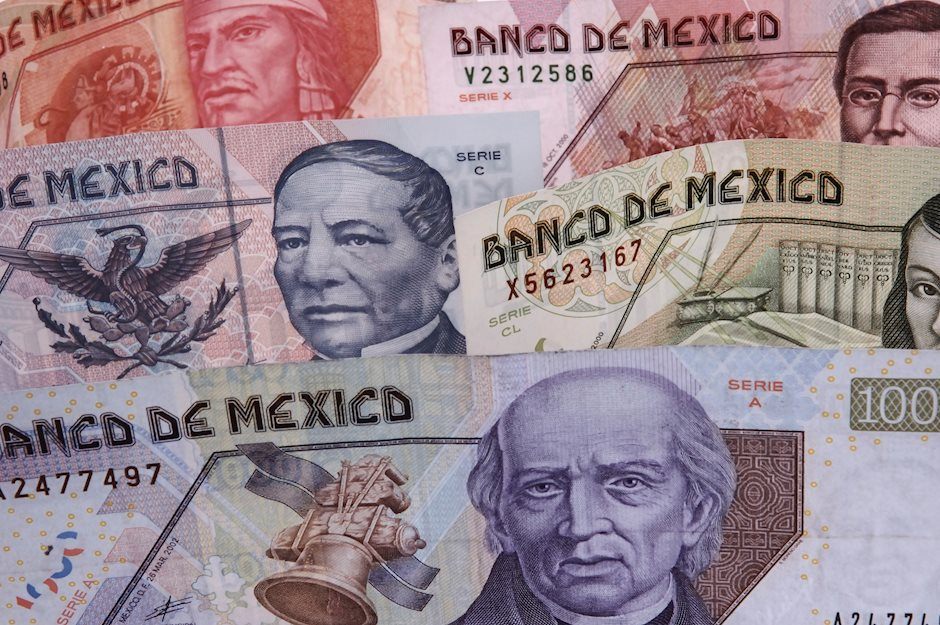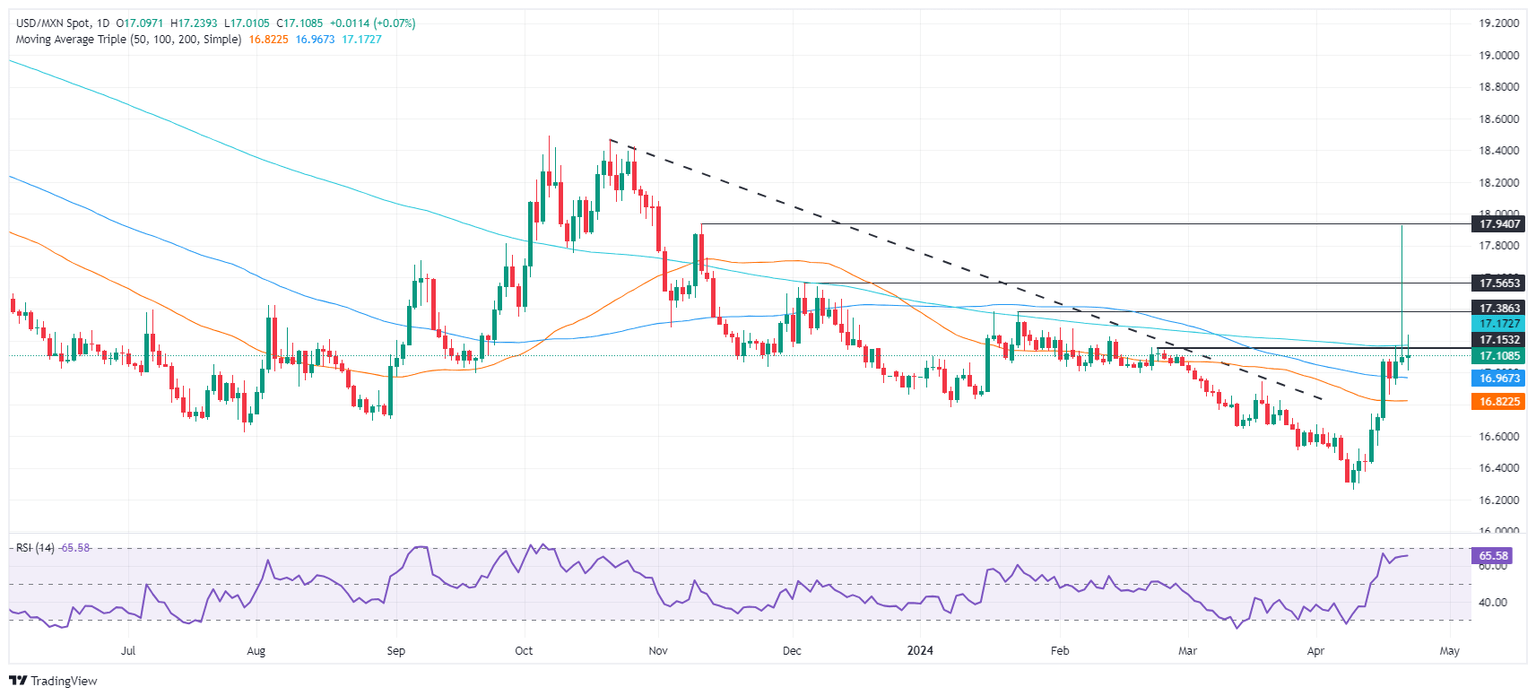Mexican Peso depreciates against US Dollar amid an economic expansion

Most recent article: Mexican Peso soars against US Dollar as US business activity slows down
- Mexican Peso dips further despite upbeat economic figures from Mexico.
- Higher US yields, strong US Dollar continue to limit Peso gains, keeping it above crucial 17.00 level.
- Banxico Governor Victoria Rodriguez suggests that upcoming election risks are factored into inflation projections, maintaining policy stability.
The Mexican Peso tumbles on Monday as the North American session reaches lunchtime, though it remains well below the year-to-date (YTD) low reached on April 19, when the USD/MXN rose toward 17.92. Positive economic data from Mexico failed to underpin the emerging market currency, while the US Dollar remains firm. The USD/MXN trades at 17.14, up by 0.42%.
Mexico’s National Statistics Agency (INEGI) revealed the economy fared better than expected in February, according to monthly and yearly figures, though higher US yields capped the USD/MXN downtrend. Meanwhile, Bank of Mexico (Banxico) Governor Victoria Rodriguez Ceja commented on Friday that Banxico already considers election risks in Mexico and the United States (US) and won’t alter the bank’s estimate that inflation would hit the institution target in Q2 2025.
Across the border, the US economic docket revealed the Chicago Fed National Activity Index in March improved, exceeding February’s upward revision, an indication of strength in the economy. That, along with Federal Reserve Chair Jerome Powell saying the lack of progress on inflation warrants keeping current policy restrictiveness, boosts the USD/MXN to stand above the psychological 17.00 figure.
Daily digest market movers: Mexican Peso treads water amid improvement on economic activity
- INEGI revealed the Economic Activity Indicator in February expanded by 1.4% MoM, up from a -0.9% contraction, and 4.4% YoY, better than the 2% in January.
- Banxico Governor Rodriguez Ceja added that services inflation is not showing a clear downward trend. She added that the Peso’s strength has, at some points, helped contain inflation since the cost of goods has not risen as quickly as before, especially because of the effect on importers.
- Last week, the International Monetary Fund (IMF) updated its economic growth projections for Mexico, reducing the 2024 growth forecast from 2.7% to 2.4% and the 2025 forecast from 1.5% to 1.4%. The IMF explains that the downward revision for 2025 is due to expected fiscal tightening by the incoming administration, which will likely reverse the current fiscal expansion, contributing to this year's growth.
- Chicago Fed National Activity Index increased to 0.15 in March from 0.09 in February. The index’s three-month moving average increased from -0.28 in February to -0.19 in March.
- Besides Powell's hawkish tilt last week, Chicago Fed President Goolsbee shifted neutral, saying that it makes sense to wait and get more clarity before easing policy, adding that the current restrictive monetary policy is appropriate.
- Earlier, Atlanta Fed President Raphael Bostic commented that the Fed might not reduce rates until the end of 2024, while the New York Fed's John Williams commented that current monetary policy is in a good place, indicating no rush to cut rates.
- Data from the Chicago Board of Trade (CBOT) suggests that traders expect the fed funds rate to finish 2024 at 4.985%, down from 4.995% last Friday.
Technical analysis: Mexican Peso slumps as USD/MXN buyers target the 200-day SMA
The Mexican Peso is on the defensive after depreciating to fresh five-month lows past 17.90. Key resistance levels were broken during the USD/MXN rally, with the 200-day Simple Moving Average (SMA) pierced at 17.16. Although buyers hadn’t been able to achieve a daily close above the latter, the risks for further Peso weakness remain.
In that outcome, the USD/MXN's next resistance would be January 23’s high at 17.38, followed by December 5’s 17.56. Once those levels are surpassed, look for a test of the 18.00 handle.
On the other hand, if the exotic pair drops below the 100-day SMA at 17.03, the 17.00 mark is up next. Once cleared, the next support would be the 50-day SMA at 16.81.
Mexican Peso FAQs
The Mexican Peso (MXN) is the most traded currency among its Latin American peers. Its value is broadly determined by the performance of the Mexican economy, the country’s central bank’s policy, the amount of foreign investment in the country and even the levels of remittances sent by Mexicans who live abroad, particularly in the United States. Geopolitical trends can also move MXN: for example, the process of nearshoring – or the decision by some firms to relocate manufacturing capacity and supply chains closer to their home countries – is also seen as a catalyst for the Mexican currency as the country is considered a key manufacturing hub in the American continent. Another catalyst for MXN is Oil prices as Mexico is a key exporter of the commodity.
The main objective of Mexico’s central bank, also known as Banxico, is to maintain inflation at low and stable levels (at or close to its target of 3%, the midpoint in a tolerance band of between 2% and 4%). To this end, the bank sets an appropriate level of interest rates. When inflation is too high, Banxico will attempt to tame it by raising interest rates, making it more expensive for households and businesses to borrow money, thus cooling demand and the overall economy. Higher interest rates are generally positive for the Mexican Peso (MXN) as they lead to higher yields, making the country a more attractive place for investors. On the contrary, lower interest rates tend to weaken MXN.
Macroeconomic data releases are key to assess the state of the economy and can have an impact on the Mexican Peso (MXN) valuation. A strong Mexican economy, based on high economic growth, low unemployment and high confidence is good for MXN. Not only does it attract more foreign investment but it may encourage the Bank of Mexico (Banxico) to increase interest rates, particularly if this strength comes together with elevated inflation. However, if economic data is weak, MXN is likely to depreciate.
As an emerging-market currency, the Mexican Peso (MXN) tends to strive during risk-on periods, or when investors perceive that broader market risks are low and thus are eager to engage with investments that carry a higher risk. Conversely, MXN tends to weaken at times of market turbulence or economic uncertainty as investors tend to sell higher-risk assets and flee to the more-stable safe havens.
Author

Christian Borjon Valencia
FXStreet
Christian Borjon began his career as a retail trader in 2010, mainly focused on technical analysis and strategies around it. He started as a swing trader, as he used to work in another industry unrelated to the financial markets.


















